The Google Pixel 4 XL Review: Stuck In The Past In 2019
by Andrei Frumusanu on November 8, 2019 11:30 AM EST- Posted in
- Mobile
- Smartphones
- Pixel 4
- Pixel 4 XL
Display Measurement
The display of the Pixel 4 is one of the phone’s main features thanks to the 90Hz refresh rate. As mentioned in the introduction, the displays on the Pixel 4 series this year is again dual-sourced between LG and Samsung. The regular Pixel 4 receives an LG panel, while the 4 XL that we’re testing and reviewing today, uses a Samsung display.
Android Q promised to have implemented a new iteration of Google’s colour management system, and for the first time, the Photos app is actually able to properly display wide gamut pictures. Unfortunately, it’s still a very limited system in apps as they cannot display differing gamut pictures side-by-side, so for example the thumbnail view is shown only in sRGB. Most importantly, Chrome by default still doesn’t support wide-gamut content as you have to force it in the engine settings, and this implementation doesn’t use the OS’s CMS handling.
We move on to the display calibration and fundamental display measurements of the Pixel 4 XL screen. As always, we thank X-Rite and SpecraCal, as our measurements are performed with an X-Rite i1Pro 2 spectrophotometer, with the exception of black levels which are measured with an i1Display Pro colorimeter. Data is collected and examined using SpectraCal's CalMAN software.

Starting off with the brightness, the Pixel 4 XL is relatively conservative as it peaks out at 438 nits in all scenarios. It’s again very odd here as Google can’t seem to make up its mind on whether it wants to offer an auto-brightness boost or not. Last year, the Pixel 3 only had it available in its Adaptive mode, whilst this year the Pixel 4 doesn’t offer it all, even though the display drivers actually has the high-brightness mode implemented.
In terms of greyscale calibration and accuracy, on my unit things differed greatly based on brightness. At maximum brightness, the Pixel 4 XL was seemingly quite accurate with good colour balance and gamma reproduction. At our standard 200cd/m² measurement point however, things are quite worse. First off, all there’s a more notable colour shift towards greens on the unit which isn’t great. Following that, there’s also creeping issues with the gamma calibration as it’s non-linear and deviates a lot more from the 2.2 target. What this results in is some shades, especially at the higher levels, appear darker than they should be.
I’ve also noted and captured some sort of bug in the display behaviour; when I was measuring at minimum brightness, I encountered some really bad results. I’ve seen this mentioned by some other reviewers and the issue went away when I toggled the screen refresh rate. The odd thing though, is that I wasn’t able to immediately reproduce it afterwards and results on the new measurements were quite ok. The colour shift the phone took was extremely noticeable at the time the bug took place.

SpectraCal CalMAN
"Natural" Greyscale colours

In terms of dE2000, the biggest culprit to the average 2.29 result for me is the green tint of whites as well as the slightly off gamma.
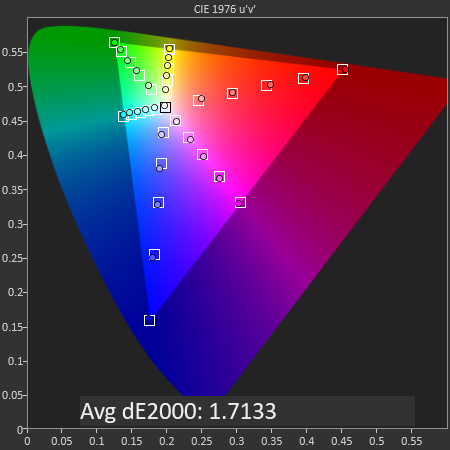
SpectraCal CalMAN
sRGB Gamut
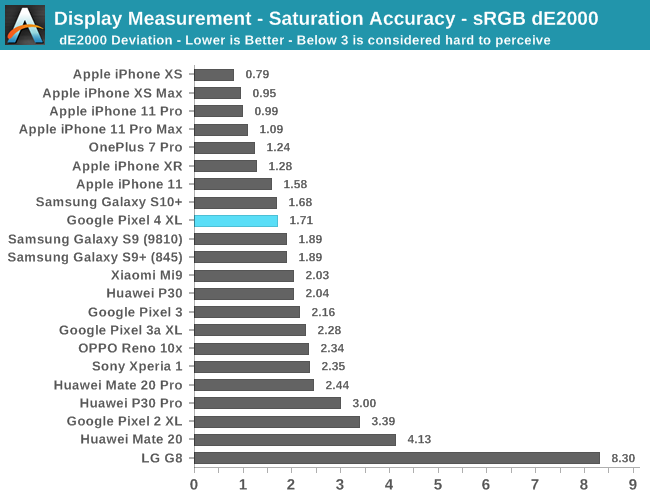
In the sRGB gamut, the Pixel 4 XL does well with a dE2000 of 1.71. The biggest issue again is a shift in the tones towards green, but also seemingly very slight oversaturation of all the tones.
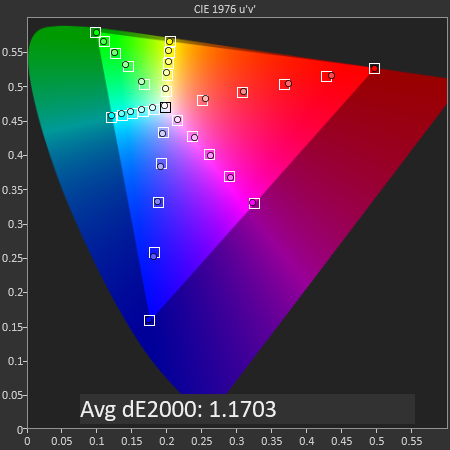
SpectraCal CalMAN
Display P3 Gamut
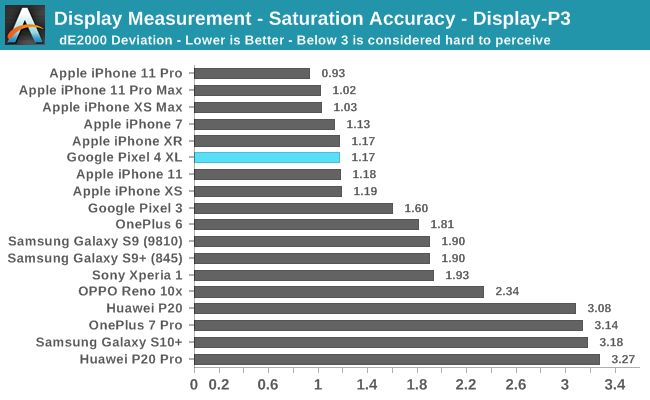
The Display P3 gamut performs a lot better. Here while the green tint is still present, the saturation levels are better and thus the Pixel 4 XL ends up with an excellent dE2000 of 1.17.

SpectraCal CalMAN
Gretag-Macbeth

Finally, in the GMB test, the Pixel 4 XL ends up quite average with a score of 2.34 as it’s showcasing tones that are too dark, a green tint in the whites, with some hue errors for a few tones.
Display Conclusion – Good, but not A+
Overall, the Pixel 4 XL’s display characteristics beyond it’s 90Hz refresh rate are quite average. Whilst Google has been able to improve the calibration compared to what we measured on the regular Pixel 3 last year and the 2 XL the year before that, it’s still quite a bit behind what some other vendors are able to achieve. The display’s lower brightness is also a bit of an issue in direct sunlight as it lacks any kind of boost behaviour. Finally, the remaining characteristics such as viewing angles and sharpness are excellent, but that’s just generally a common characteristic of panels with these specifications.
The results today aren’t really a surprise to me given Google’s track record with the displays on the Pixel series, however it does stand in contrast to what the company was proclaiming at launch: “A+ rating Best Smartphone Display Awards” really doesn’t mean anything at all if, first of all, it’s a sponsored award, and secondly, if the measurements aren’t representative of a random production unit. Make of it what you will.


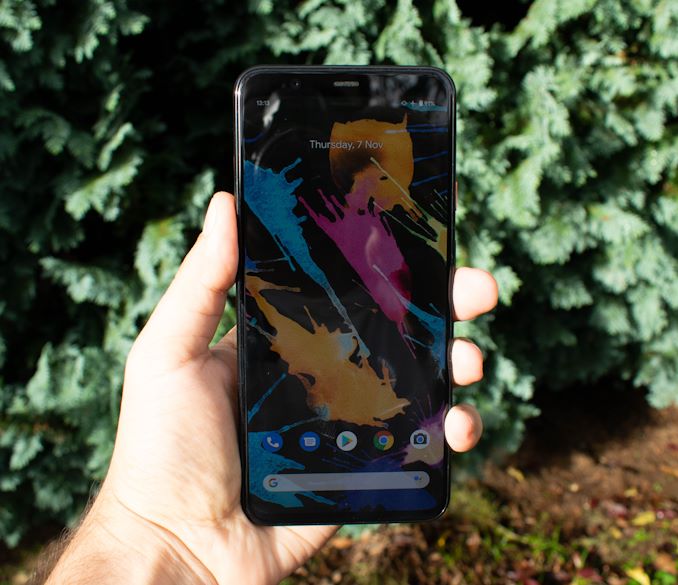
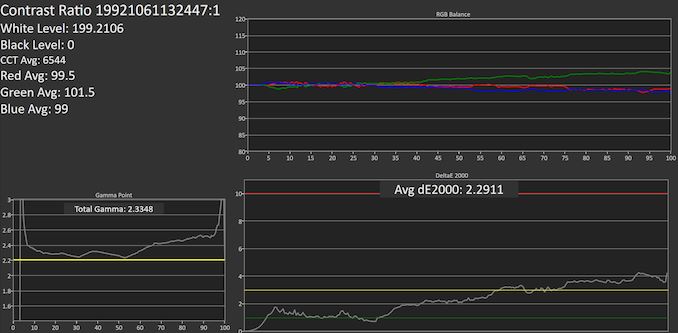
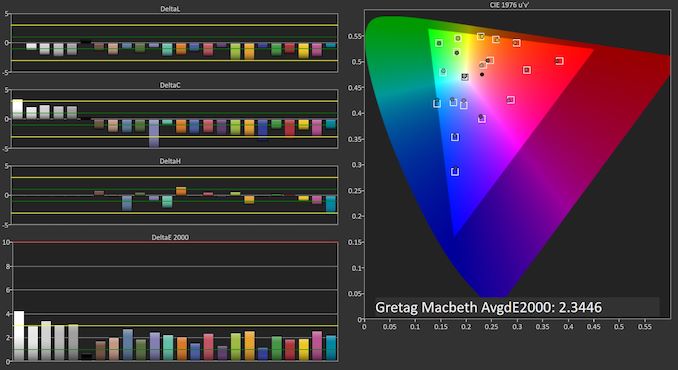








159 Comments
View All Comments
MaxUserName - Saturday, November 9, 2019 - link
You especially do not take pictures in very high-contrast scenes to hide the fact that the Google Camera does not work real HDR?swood15 - Saturday, November 9, 2019 - link
I was in the market for a new phone but wanted to wait for the Pixel 4 to drop before making a decision, ended up going with a OP7 Pro. Same SoC, 2x the RAM, 4x the storage, arguably a better implementation of the 90Hz display, larger battery, no forehead/notch, a respectable camera, and a clean OS for $50 cheaper than the cheapest Pixel 4?! Google needs to get serious.Bragabondio - Saturday, November 9, 2019 - link
Love Pixel devices as specs are not all. My feeling is that in the last few years phones are fast enough so specs in terms of pure speed are mostly meaningless unless you have some special case that I don have. Unlocked boot-loader, guaranteed fastest updates for 3 years and freedom to sideload apps is a big plus. Best camera on the market, IP68 dust and water resistance are also a must in my book and both Pixel 4 have them.I agree that the original price is to high ($799 for the regular version and $899 for the XL version) but with a recent $200 discount the new price is $599 for the regular version and $699 for the XL version making them much more reasonable buy.
I am personally skipping Pixel 4 as I plan to upgrade my Pixel 2 next year with Pixel 5.
Arbie - Saturday, November 9, 2019 - link
• No 3.5mm headphone jack.• No sale.
s.yu - Sunday, November 10, 2019 - link
I agree, not that the rest of this package would appeal to me if it even had the jack.For example:
• No 256GB+ storage.
• No sale.
Medstar1 - Sunday, November 10, 2019 - link
Interesting that the reviewer rigged Google for not introducing an ultra wide lens like their rivals; thus, ignoring the fact that LG introduced this feature several years ago.Andrei Frumusanu - Sunday, November 10, 2019 - link
What's your point? LG being first to the UWA doesn't change the fact that Google's the only vendor this year not having it.LG was first to it and I've always said it's a great addition to the camera experience, but it was Huawei in 2018 which popularised it as the UWA quality was far ahead of what LG was able to ever offer.
Oliseo - Sunday, November 10, 2019 - link
I would have said that the Pixels MAIN issue is the woefully short support timeframe from Google.3 years of support IS NOT ENOUGH for the price, regardless of anything else.
bengoey - Saturday, November 23, 2019 - link
Agree, my original 2016 Pixel won't have anymore updates from January 2020, so 3 years update only. If I bought an iPhone instead it will still have software update at least until the end of 2020, may be more. The camera of the Pixel however was better than iPhone at the time. Now iPhone 11 camera has improved and the video is better than the Pixel 4, if I am to upgrade I would buy the Iphone 11 , not the Pixel 4. To upgrade the memory to 128Gb will cost me £50 for the iphone 11 and £100 for the Pixel 4SirKronan - Sunday, November 10, 2019 - link
Yet another newly released phone with its full review complete, but still no word on the Note 10/10+ review?Is Anandtech not going to review the new Note phones after all? That would be a shame.